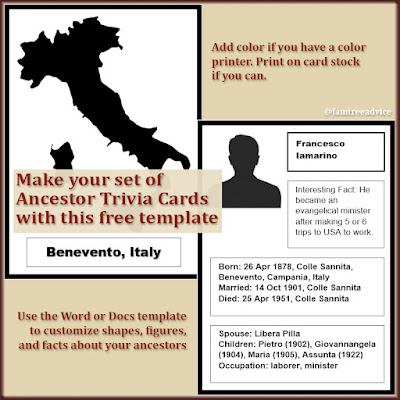While figuring out a new DNA match, I found her great grandfather's 1903 ship manifest. His last name told me he came from my grandfather's town of Colle Sannita. I even have a copy of his 1884 Italian birth record in my family tree.
But his immigration record itself was an amazing find. Of the 30 lines on the page, 25 are men from the same town. Now that I've finished my One Place Study of Colle Sannita, I'm perfectly positioned to ID these 25 men. My colossal family tree should contain each one of them.
The beauty of following through on this one ship manifest is that it will add data points to 25 cold trails.
Let's examine one of the more fruitful searches to see how much we can learn from this random find.
 |
| Your person is likely to have traveled with others from their hometown. Don't overlook other members of your family tree. |
Subject: Onofrio Zeolla
The clues from the 1903 ship manifest include:
- He is 33 years old
- He is married
- He is joining his brother-in-law Nicola Palmiero in Adamsburg, Pennsylvania
When I looked for him in my family tree, there was only one good choice. Onofrio, born in 1870, is my 2nd cousin 3 times removed. Since his wife's last name was Callara, I checked his sisters to see if one had married a Nicola Palmiero.
Yes. His sister Maddalena married Nicola Palmiero. They had 2 children before he left for Pennsylvania.
I know Onofrio and his wife had at least 7 children between 1896 and 1914. I noticed I'd left a standard note on the 1903 birth of his daughter. It says, "Her father was in America when she was born." This fact comes from a note on the daughter's birth record.
Knowing that I'd found the right Onofrio Zeolla, I searched for any other U.S. records he may have left behind.
I found another ship manifest from March 1909. Onofrio went to join his cousin Giorgio Zeolla in Connellsville, Pennsylvania. Sure enough, a note on the September 1909 birth record of his son Angelo says his father was in America when he was born.
I found Onofrio's name listed on his eldest son Michele's U.S. World War I draft registration card. (Michele is Italian for Michael.) He was born in Colle Sannita in 1896. In 1918 Michele was working at the U.S. Cast Iron Foundry in Scottdale, Pennsylvania. His draft card has a unique note written in the center. It says, "Wants to go soon." So Michele was not planning to stay in America. Like his father, he came here only to earn some money to keep his family afloat.
 |
| Searching for one man, I wound up constructing the lives of his eldest son and grandson. |
But did Michele ever go home? I found his 1952 Pennsylvania death certificate. He was 55 years old, married, and still working at a foundry in Scottdale.
Clearly Michele needed more research. I found:
- His 1913 arrival in the U.S. at age 17. He was joining his uncle Giorgio Zeolla in Connellsville, Pennsylvania.
- His 1918 U.S. Army service card. He was a Private, honorably discharged on 13 Dec 1918. I guess he wanted to go home but never did.
- His 1934 application for veteran's compensation. This wonderful find lists his wife's maiden name, and their son Nicholas. He was the informant on Michele's death certificate, but it didn't say his relationship. This document has both his parents' names; his mother is missing from his death certificate.
- His 1942 U.S. World War II draft registration card. He and his wife Edith live in Scottdale.
- His 1952 veterans burial card. A photo of his gravemarker lists his military rank and unit proudly.
- His 1930, 1940, and 1950 censuses. Michele, his wife and son are living with his wife's parents in Scottdale each time.
I searched for more about Michele's son Nicholas. He graduated Scottdale High School in 1944 where he played in the band. He served in the U.S. Army Air Force, signing up immediately after graduation. He's buried in a military cemetery. He and his wife Margaret married in Nevada and honeymooned in Mexico.
I began with nothing but birth records for my Italian townspeople. Then a single ship manifest took me on a journey through their lives in America. And there are 24 other townsmen on that ship manifest!


